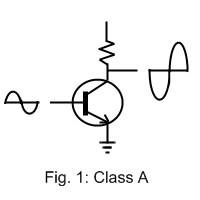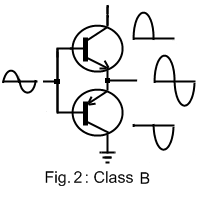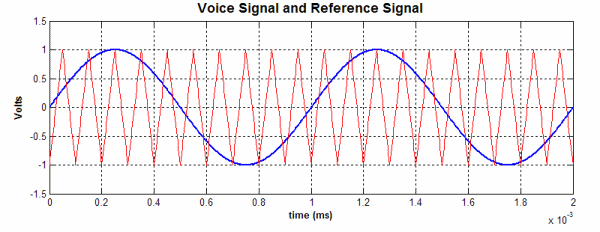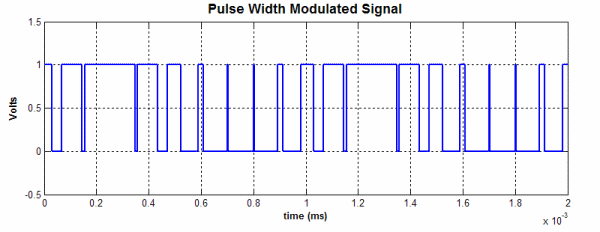Why are Class D amplifiers so Efficient?
To understand why class D amplifiers operate with such great energy efficiency, a brief introduction to other amplifiers is in order.
Amplifiers are active devices, which by definition, require external power sources. An amplifier uses energy from these sources to amplify an input signal. What differentiates classes of amplifiers is the method of how the energy is used and how amplification is achieved.

 Class A amplifiers, shown to the left, are the simplest configurations as well as the least efficient. Class A amplifiers continuously conduct and are said to operate in a linear mode. The output of a class A amplifier is simply an amplified version of the input and uses the external power supplies to achieve this. But what if there is no input signal? Well, the power sources continue to supply current to the amplifier and thus gets wasted.
The reason that class A is so inefficient should now be apparent. Enter class B.
Class B amplifiers, shown to the right, use a clever trick to prevent the amplifier from wasting the power supply's energy. Rather than be in a continuous conduction state, a class B amplifier uses 2 different branches. One branch will conduct only when the input signal is above 0 Volts. When the input signal falls below this line, the second branch begins
to conduct while the first is shut off. In this way, the class B amplifier conducts only when an input signal is present. A variation that corrects distortion in a class B amplifier is a class AB amplifier. Both operate with this "pull/pull" method, in which the amplifier conducts only part of the time. This leads to much greater efficiency, with a theoretical limit of 78.5%.
Class A amplifiers, shown to the left, are the simplest configurations as well as the least efficient. Class A amplifiers continuously conduct and are said to operate in a linear mode. The output of a class A amplifier is simply an amplified version of the input and uses the external power supplies to achieve this. But what if there is no input signal? Well, the power sources continue to supply current to the amplifier and thus gets wasted.
The reason that class A is so inefficient should now be apparent. Enter class B.
Class B amplifiers, shown to the right, use a clever trick to prevent the amplifier from wasting the power supply's energy. Rather than be in a continuous conduction state, a class B amplifier uses 2 different branches. One branch will conduct only when the input signal is above 0 Volts. When the input signal falls below this line, the second branch begins
to conduct while the first is shut off. In this way, the class B amplifier conducts only when an input signal is present. A variation that corrects distortion in a class B amplifier is a class AB amplifier. Both operate with this "pull/pull" method, in which the amplifier conducts only part of the time. This leads to much greater efficiency, with a theoretical limit of 78.5%.
So how does class D work?
Class D amplifiers first modify an input signal before amplification takes place. The input signal is compared with a triangular waveform that serves as a reference signal.

The output of the comparator rails to +V, in this case 1 Volt, when the voice signal is greater than the reference signal. Conversely, the comparator drops to 0 when the voice signal is less than the reference signal.

What is occuring is that a comparator is creating a pulsed waveform in which the distance between pulses is related to the frequencies of the input signal. In fact, it is referred to as a pulse-width modulated signal. So why is this important? Well, this configuration exploits the relationship between voltage, current, and power. Simply put, power (Watts) is the product of voltage times current. We saw in the class A amplifier that a current always exists. In a class D amplifier, there is only a current when the comparator rails to +V. However, at that moment, when the current has just reached its maximum, the voltage across the amplifier drops to zero, thus the power is zero. When the input signal is less than the reference signal and the comparator changes to 0, the current passing through the class D amplifier also drops to zero and once again, the power is zero. Therefore, energy is consumed by a class D amplifier only during the short transition phases of the comparator. This method makes it possible to amplify an input signal by containing the information within a variable width square wave, and thus using very little power to do it.
Okay, but the output of the amplifier is a square wave. How do I recover my original signal?
The magic of recovering the original signal from the pulse-width modulated signal lies in Fourier analysis. Briefly, Fourier analysis predicts that any signal can be decomposed into a sum of wieghted sinusoids. This type of transformation is called a Fourier Series. This means that even our square wave can be written as a sum of individual sinusoids! Well, we want to keep only the first few sinusoids. More exactly, we only want to retain the sinusoids up to the full bandwidth of our input signal. The trick: Low-pass filter. By applying the pulse-width modulated signal to a low-pass filter, we are able to recover our original signal, whose values are now amplified thanks to the class D amplifier.
The importance of all this lies in the fact that by consuming so little power, class D amplifiers require very little energy and expel very little heat to its surroundings. This type of amplification has allowed the miniturization of most modern electronic devices. Class D is likely the way of the future and we are employing this exciting technology in our improved drive-thru system.